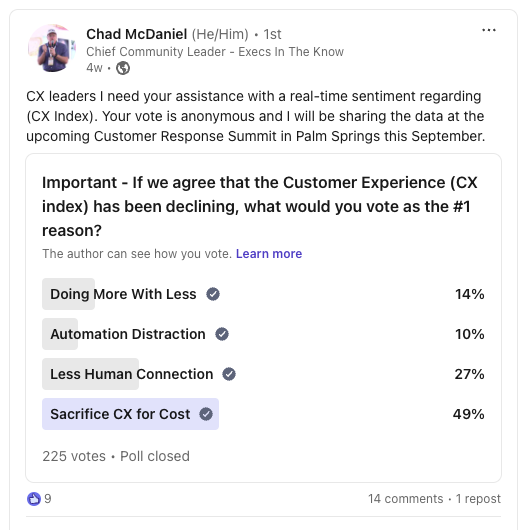Americans are more dissatisfied with the customer service they receive than ever before. According to the latest Forrester Customer Experience Index (CX Index™), this year marks the third consecutive decline in CX quality.
The Forrester CX Index is a key metric that evaluates the quality of customer service and loyalty across nearly 500 brands in 14 industries. This annual survey offers a window into what today’s consumers think about their interactions with brands. The 2024 results are concerning, with 39 percent of brands reporting a drop in service quality, a significant increase from 17 percent in 2023.
This year’s average decline was 3.9 points, surpassing the previous year’s drop of 3.6. The overall CX Index score has now hit a record low of 69.3, dipping below the previous low of 69.6 set in 2017.
What’s driving this downward trend in customer satisfaction? Are brands failing to meet evolving customer expectations, or is there a deeper issue at play?
The report attributes the decline to several factors, including:
- The inability to provide seamless customer and employee experiences.
- Underwhelming digital experiences using chatbots.
- Consumers’ concerns about their personal financial situations, society, and the economy at large.
- The emergence of generative AI, which has led consumers to expect more from conversational experiences.
- Lack of customer obsession among leaders, with only three percent of companies considered customer-obsessed.
Inability to Provide Seamless Customer and Employee Experiences
When was the last time you experienced a seamless interaction with a brand, where you felt like every touchpoint was connected and purposeful? For too many consumers, these moments are becoming rarer, and that’s a problem. The disconnect between customer and employee experiences is palpable, creating friction that erodes trust and loyalty.
Are we as CX leaders doing enough to bridge this gap, or are we allowing silos to dictate the customer journey? It’s time to reflect on how we can ensure that our teams and technology are aligned to deliver the seamless experiences that customers expect.
Underwhelming Digital Experiences Using Chatbots
Chatbots were supposed to revolutionize customer service, providing quick, efficient responses to customer inquiries. But let’s be honest—how often do we hear frustration from customers who feel stuck in a never-ending loop with an unhelpful bot?
It’s not that chatbots don’t have potential; it’s that we’re not leveraging them effectively. Are we listening to customer feedback and iterating on these digital tools, or are we just deploying them and hoping for the best? We must reconsider how we design and implement these experiences, ensuring they add value rather than just serve as a stopgap.
Consumers’ Concerns About Their Financial Situations, Society, and the Economy
In today’s uncertain economic climate, how can we expect our customers to remain loyal if we don’t address the broader concerns weighing on their minds? Personal financial stress, societal shifts, and economic instability are no longer background noise—they’re central to how consumers evaluate their interactions with brands.
Are we considering these factors in our CX strategies, or are we still operating as if customers exist in a vacuum? The reality is that understanding these external pressures is key to fostering deeper connections and building trust with our customers.
Lack of Customer Obsession Among Leaders
Customer obsession isn’t just a buzzword; it’s a mindset. With only three percent of companies considered truly customer-obsessed, it begs the question: Why aren’t more leaders adopting this approach? Are we too focused on short-term gains, or is there a deeper reluctance to put the customer at the center of everything we do? It’s time for a reality check—are we, as leaders, willing to do what it takes to foster a culture of customer obsession, or are we content with business as usual?
The Emergence of Generative AI, Which Has Led Consumers to Expect More from Conversational Experiences
Rising consumer expectations are a significant factor. Today’s consumers have experienced firsthand the innovative approaches of leading brands, setting a new benchmark for all businesses. What’s more, the most significant challenge in delivering exceptional customer experiences is that consumer expectations are not just high—they’re constantly evolving and rising.
Customers expect faster, smoother, and more personalized interactions. What was once cutting-edge, like a 24/7 chatbot, is now considered standard—perhaps even outdated. As disruptive companies push the boundaries of what’s possible, customer expectations are set to keep climbing.
GenAI is the new frontier, and a seismic shift in consumer expectations comes with it. Customers now expect more personalization, accuracy, and human-like conversations from their interactions with brands. Are we ready to meet these heightened expectations, or are we falling short?
As CX leaders, we must ask ourselves if we’re truly prepared to harness the power of AI to enhance customer interactions or if we’re just scratching the surface. The opportunity is vast, but so is the potential for disappointment if we don’t get it right.
This increasing demand for excellence is placing unprecedented pressure on companies. As businesses strive to meet ever-rising customer expectations, they face a paradoxical challenge: delivering superior customer experiences while managing the financial constraints that come with the current economic landscape. The pressure to innovate and personalize interactions is at an all-time high, yet companies must also find ways to cut costs to stay competitive.
Cost-Cutting
This balancing act has led to difficult decisions, with cost-cutting measures often impacting the very customer experience that brands are working so hard to enhance. As a result, companies are tasked with finding creative solutions to maintain the quality of their CX initiatives without sacrificing financial stability. Cost-cutting across industries has become an unavoidable reality. This summer, we’ve seen a wave of job cuts—an unfortunate but telling sign of the times. Brands are grappling with the need to trim expenses, and often, it’s CX that feels the pinch.
Businesses are labeling these cuts as “difficult but necessary” and part of a broader “comprehensive reduction in spending.” A recent LinkedIn poll by Chad McDaniel, President and Co-Founder of Execs In The Know, underscores this concern, revealing that 49 percent of CX leaders believe that companies are indeed sacrificing CX in favor of cost savings.

This cost-conscious approach is visible in the shrinking headcounts in customer-facing roles and the scaling back of initiatives that directly influence customer satisfaction. In 2024 alone, the tech industry has witnessed over 124,000 layoffs. For some smaller startups, the financial pressures have been insurmountable, leading to closures.
However, the complexity that emerges from increased automation and self-service options is often overlooked in these cost-cutting measures. While the financial benefits of self-service are clear, the unintended consequence is that remaining live agent calls become more challenging. These tougher interactions present a heightened CX risk, as agents are left to handle the most complex issues without adequate support.
We’re witnessing a cyclical challenge: rising labor costs drive the push toward automation, which leaves behind more intricate and time-consuming calls. These calls require highly skilled personnel, further driving up labor costs, and the cycle continues. The reality is that the typical agent now needs to navigate five or more systems to resolve a single interaction—adding layers of difficulty to an already demanding role. It’s evident that there’s a growing need for agent enablement technology to help break this cycle and support agents in delivering the high-quality service that customers expect.
Efficiency is a natural goal, but the rush toward automation and reduced human interaction can create unintended consequences. No one sets out to compromise CX, but the missing piece in many organizations is a solid foundation of decision intelligence. Managers often lack the critical data to make informed decisions aligning business objectives with CX outcomes.
Moreover, there seems to be a disconnect between senior management and those on the front lines of CX. The individuals executing CX strategies don’t always clearly understand how to align their efforts with broader business goals. There’s also an overemphasis on support and success functions, which, while valuable, gather rich insights underutilized by the rest of the organization. The key is to align these insights across all departments to reduce the need for reactive measures and ensure that CX initiatives are fully integrated with the company’s overall strategy.
As companies optimize for speed and excellence by reducing redundancies and enhancing efficiency, will these measures stretch teams thin, further impacting the quality of CX?
Keeping Customers #1
In the face of declining customer satisfaction, the challenge for companies is clear: balancing innovation and efficiency with the human touch that customers still value. As AI continues to reshape industries, it’s tempting to lean heavily on automation to cut costs and streamline operations. But in doing so, brands may risk losing the very essence of what makes customer service exceptional—the genuine, personalized interactions that foster loyalty and trust.
The path forward requires more than just adopting the latest technologies or implementing cost-cutting measures. It calls for a renewed commitment to keeping customers at the heart of every decision. This means investing in both people and technology, ensuring that advancements enhance, rather than diminish, the quality of the customer experience.
The brands that will emerge as leaders are those that recognize the power of blending the best of both worlds—leveraging AI to improve efficiency while maintaining the human connections that set them apart. In a world where customer expectations are only set to rise, the true winners will be those who never lose sight of their most valuable asset: their customers.






















































 TELUS Digital
TELUS Digital ibex delivers innovative BPO, smart digital marketing, online acquisition technology, and end-to-end customer engagement solutions to help companies acquire, engage and retain customers. ibex leverages its diverse global team and industry-leading technology, including its AI-powered ibex Wave iX solutions suite, to drive superior CX for top brands across retail, e-commerce, healthcare, fintech, utilities and logistics.
ibex delivers innovative BPO, smart digital marketing, online acquisition technology, and end-to-end customer engagement solutions to help companies acquire, engage and retain customers. ibex leverages its diverse global team and industry-leading technology, including its AI-powered ibex Wave iX solutions suite, to drive superior CX for top brands across retail, e-commerce, healthcare, fintech, utilities and logistics.






















 Trista Miller
Trista Miller




























